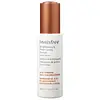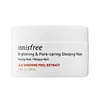What's inside
What's inside
 Key Ingredients
Key Ingredients

 Benefits
Benefits

 Concerns
Concerns

 Ingredients Side-by-side
Ingredients Side-by-side

Water
Skin ConditioningPropanediol
SolventPanthenol
Skin ConditioningGlycerin
HumectantAlcohol Denat.
AntimicrobialNiacinamide
SmoothingCeramide AP
Skin Conditioning1,2-Hexanediol
Skin ConditioningCitric Acid
BufferingSodium Chloride
MaskingXanthan Gum
EmulsifyingGellan Gum
Sodium Citrate
BufferingCitrus Reticulata Peel Extract
Skin ConditioningLimonene
PerfumingEthylhexylglycerin
Skin ConditioningParfum
MaskingMagnesium Sulfate
Disodium EDTA
Hyaluronic Acid
Humectant3-O-Ethyl Ascorbic Acid
Skin ConditioningLinalool
PerfumingTocopherol
AntioxidantWater, Propanediol, Panthenol, Glycerin, Alcohol Denat., Niacinamide, Ceramide AP, 1,2-Hexanediol, Citric Acid, Sodium Chloride, Xanthan Gum, Gellan Gum, Sodium Citrate, Citrus Reticulata Peel Extract, Limonene, Ethylhexylglycerin, Parfum, Magnesium Sulfate, Disodium EDTA, Hyaluronic Acid, 3-O-Ethyl Ascorbic Acid, Linalool, Tocopherol
Water
Skin ConditioningPropanediol
SolventCitrus Unshiu Peel Extract
MaskingGlycerin
HumectantCyclopentasiloxane
EmollientAlcohol
AntimicrobialArbutin
AntioxidantCyclohexasiloxane
EmollientPentaerythrityl Tetraethylhexanoate
EmollientHydrogenated Vegetable Oil
EmollientStearic Acid
CleansingPalmitic Acid
EmollientAcrylates/C10-30 Alkyl Acrylate Crosspolymer
Emulsion StabilisingAmmonium Acryloyldimethyltaurate/Vp Copolymer
Polyacrylate-13
Dimethicone
EmollientDimethicone/PEG-10/15 Crosspolymer
Tromethamine
BufferingPhenoxyethanol
PreservativePolyisobutene
Glyceryl Caprylate
EmollientParfum
MaskingEthylhexylglycerin
Skin ConditioningDisodium EDTA
Polysorbate 20
EmulsifyingSorbitan Isostearate
EmulsifyingPolymethyl Methacrylate
Myristic Acid
CleansingDextrin
AbsorbentTheobroma Cacao Extract
Skin ConditioningLauric Acid
CleansingButylene Glycol
HumectantProtease
ExfoliatingCamellia Japonica Leaf Extract
Skin ConditioningCamellia Sinensis Leaf Extract
AntimicrobialOpuntia Coccinellifera Fruit Extract
Skin ConditioningOrchid Extract
Skin ConditioningPapain
Skin ConditioningPEG-75
HumectantWater, Propanediol, Citrus Unshiu Peel Extract, Glycerin, Cyclopentasiloxane, Alcohol, Arbutin, Cyclohexasiloxane, Pentaerythrityl Tetraethylhexanoate, Hydrogenated Vegetable Oil, Stearic Acid, Palmitic Acid, Acrylates/C10-30 Alkyl Acrylate Crosspolymer, Ammonium Acryloyldimethyltaurate/Vp Copolymer, Polyacrylate-13, Dimethicone, Dimethicone/PEG-10/15 Crosspolymer, Tromethamine, Phenoxyethanol, Polyisobutene, Glyceryl Caprylate, Parfum, Ethylhexylglycerin, Disodium EDTA, Polysorbate 20, Sorbitan Isostearate, Polymethyl Methacrylate, Myristic Acid, Dextrin, Theobroma Cacao Extract, Lauric Acid, Butylene Glycol, Protease, Camellia Japonica Leaf Extract, Camellia Sinensis Leaf Extract, Opuntia Coccinellifera Fruit Extract, Orchid Extract, Papain, PEG-75
 Reviews
Reviews

Ingredients Explained
These ingredients are found in both products.
Ingredients higher up in an ingredient list are typically present in a larger amount.
Disodium EDTA plays a role in making products more stable by aiding other preservatives.
It is a chelating agent, meaning it neutralizes metal ions that may be found in a product.
Disodium EDTA is a salt of edetic acid and is found to be safe in cosmetic ingredients.
Learn more about Disodium EDTAEthylhexylglycerin (we can't pronounce this either) is commonly used as a preservative and skin softener. It is derived from glyceryl.
You might see Ethylhexylglycerin often paired with other preservatives such as phenoxyethanol. Ethylhexylglycerin has been found to increase the effectiveness of these other preservatives.
Glycerin is already naturally found in your skin. It helps moisturize and protect your skin.
A study from 2016 found glycerin to be more effective as a humectant than AHAs and hyaluronic acid.
As a humectant, it helps the skin stay hydrated by pulling moisture to your skin. The low molecular weight of glycerin allows it to pull moisture into the deeper layers of your skin.
Hydrated skin improves your skin barrier; Your skin barrier helps protect against irritants and bacteria.
Glycerin has also been found to have antimicrobial and antiviral properties. Due to these properties, glycerin is often used in wound and burn treatments.
In cosmetics, glycerin is usually derived from plants such as soybean or palm. However, it can also be sourced from animals, such as tallow or animal fat.
This ingredient is organic, colorless, odorless, and non-toxic.
Glycerin is the name for this ingredient in American English. British English uses Glycerol/Glycerine.
Learn more about GlycerinParfum is a catch-all term for an ingredient or more that is used to give a scent to products.
Also called "fragrance", this ingredient can be a blend of hundreds of chemicals or plant oils. This means every product with "fragrance" or "parfum" in the ingredients list is a different mixture.
For instance, Habanolide is a proprietary trade name for a specific aroma chemical. When used as a fragrance ingredient in cosmetics, most aroma chemicals fall under the broad labeling category of “FRAGRANCE” or “PARFUM” according to EU and US regulations.
The term 'parfum' or 'fragrance' is not regulated in many countries. In many cases, it is up to the brand to define this term.
For instance, many brands choose to label themselves as "fragrance-free" because they are not using synthetic fragrances. However, their products may still contain ingredients such as essential oils that are considered a fragrance by INCI standards.
One example is Calendula flower extract. Calendula is an essential oil that still imparts a scent or 'fragrance'.
Depending on the blend, the ingredients in the mixture can cause allergies and sensitivities on the skin. Some ingredients that are known EU allergens include linalool and citronellol.
Parfum can also be used to mask or cover an unpleasant scent.
The bottom line is: not all fragrances/parfum/ingredients are created equally. If you are worried about fragrances, we recommend taking a closer look at an ingredient. And of course, we always recommend speaking with a professional.
Learn more about ParfumPropanediol is an all-star ingredient. It softens, hydrates, and smooths the skin.
It’s often used to:
Propanediol is not likely to cause sensitivity and considered safe to use. It is derived from corn or petroleum with a clear color and no scent.
Learn more about PropanediolWater. It's the most common cosmetic ingredient of all. You'll usually see it at the top of ingredient lists, meaning that it makes up the largest part of the product.
So why is it so popular? Water most often acts as a solvent - this means that it helps dissolve other ingredients into the formulation.
You'll also recognize water as that liquid we all need to stay alive. If you see this, drink a glass of water. Stay hydrated!
Learn more about Water